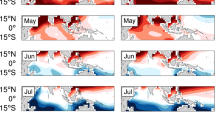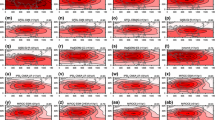Abstract
The long-term trend and seasonal variability of sea surface temperature (SST) over tropical Indo-Pacific region under the global warming projection simulated by FIO-ESM model are analyzed. At seasonal time scale, significant warming trend over Indo-Pacific area is well captured by FIO-ESM model over the warm pool region under RCP8.5 scenario. The La Niña-like warming pattern is dominant in the tropical Pacific and the negative Indian Ocean Dipole warming pattern takes place in the Indian Ocean in global warming projection separately. The strength of SST warming trend is found to be seasonal dependent over Indo-Pacific region. The spatial distribution of calendar month where fastest/slowest SST warming trend take place in tropical Indo-Pacific has been assessed in FIO-ESM simulation, which is corresponded with the distribution of SST climatology closely in Pacific but not in Indian Ocean.









Similar content being viewed by others
References
Allen, S. K., Plattner, G. K., Nauels, A., Xia, Y., & Stocker, T. F. (2007). Climate change 2013: the physical science basis. An overview of the working group 1 contribution to the fifth assessment report of the intergovernmental panel on climate change (IPCC). Computational Geometry, 18(2), 95–123.
Bellenger, H., Guilyardi, E., Leloup, J., et al. (2014). ENSO representation in climate models: from CMIP3 to CMIP5. Climate Dynamics, 42(7–8), 1999–2018.
Cai, W., Borlace, S., Lengaigne, M., et al. (2014). Increasing frequency of extreme El Niño events due to greenhouse warming. Nature Climate Change, 4, 111–116.
Cane, M. A., Clement, A. C., Kaplan, A., et al. (1997). Twentieth-Century sea surface temperature trends. Science, 275(5302), 957–960.
Chiang, J. C., & Friedman, A. R. (2012). Extratropical cooling, interhemispheric thermal gradients, and tropical climate change. Annual Review of Earth and Planetary Sciences, 40(1), 383–412.
Collins, W. D., Rasch, P. J., Boville, B. A., et al. (2006). The formulation and atmospheric simulation of the Community Atmosphere Model version 3 (CAM3). Journal of Climate, 19(11), 2144–2161.
De Deckker, P. (2016). The Indo-Pacific Warm Pool: Critical to world oceanography and world climate. Geoscience Letters, 3(1), 20.
Dickinson, R. E., Oleson, K. W., Bonan, G., et al. (2006). The community land model and its climate statistics as a component of the community climate system model. Journal of Climate, 19(11), 2302–2324.
Grose, M. R., Brown, J. N., Narsey, S., et al. (2014). Assessment of the CMIP5 global climate model simulations of the western tropical Pacific climate system and comparison to CMIP3. International Journal of Climatology, 34, 3382–3399.
Huang, P., & Ying, J. (2015). A multimodel ensemble pattern regression method to correct the tropical Pacific SST change patterns under global warming. Journal of Climate, 28(12), 4706–4723.
Hunke, E. C., Lipscomb, W. H., et al. (2008). CICE: The Los Alamos sea ice model. Documentation and software user’s manual. Version 4.0, Technology Reports. LA-CC-06–012, T-3 Fluid Dynamic Group, Los Alamos National Laboratory, Los Alamos, New Mexico. Available online at http://www.ccsm.ucar.edu/models/ccsm4.0/ccsmdoc/book1.html.
Kim, S. T., & Yu, J. (2012). The two types of ENSO in CMIP5 models. Geophysical Research Letters, 39(11), 221–228.
Kohyama, T., Hartmann, D. L., & Battisti, D. S. (2017). La Niña-like mean-state response to global warming and potential oceanic roles. Journal of Climate, 30(11), 4207–4225.
Liu, L., Xie, S.-P., Zheng, X.-T., et al. (2014). Indian Ocean variability in the CMIP5 multi-model ensemble: the zonal dipole mode. Climate Dynamics. https://doi.org/10.1007/s00382-013-2000-9.
Liu, L., Yu, W., & Li, T. (2011). Dynamic and thermodynamic air-sea coupling associated with the indian ocean dipole diagnosed from 23WCRP CMIP3 models. Journal of Climate, 24(18), 4942–4958.
Oleson, K. W., Niu, G. Y., Yang, Z. L., Lawrence, D. M., Thornton, P. E., Lawrence, P. J., et al. (2008). Improvements to the community land model and their impact on the hydrological cycle. Journal of Geophysical Research, 113(G1), G01021.
Qiao, F., Song, Z., Bao, Y., et al. (2013). Development and evaluation of an Earth System Model with surface gravity waves. Journal of Geophysical Research: Oceans, 118(9), 4514–4524.
Qiao, F., Yuan, Y., Yang, Y., Zheng, Q., Xia, C., & Ma, J. (2004). Wave-induced mixing in the upper ocean: Distribution and application to a global ocean circulation model. Geophysical Research Letters. https://doi.org/10.1029/2004GL019824.
Smith, R., Jones, P. W., et al. (2010). The Parallel Ocean Program (POP) reference manual, ocean component of the community climate system model (CCSM). Los Alamos National Laboratory Technology Reports. LAUR-10-01853. Available online at http://www.cesm.ucar.edu/models/cesm1.0/pop2/doc/sci/POPRef-Manual.pdf.
Song, Z., Qiao, F., & Song, Y. (2012). Response of the equatorial basin-wide sst to non-breaking surface wave-induced mixing in a climate model: An amendment to tropical bias. Journal of Geophysical Research, 117, C00J26.
Taylor, K. E., Stouffer, R. J., & Meehl, G. A. (2012). An overview of CMIP5 and the experimental design. American Meteorological Society, 93(4), 485–498.
Vecchi, G. A., Clement, A., & Soden, B. J. (2008). Examining the tropical pacific’s response to global warming. Eos Transactions American Geophysical Union, 89(9), 81–83.
Weller, E., Min, S. K., Cai, W., Zwiers, F. W., Kim, Y. H., & Lee, D. (2016). Human-caused Indo-Pacific warm pool expansion. Science Advances, 2(7), e1501719.
Xie, S. P., Deser, C., Vecchi, G. A., Collins, M., Delworth, T. L., Hall, A., et al. (2015). Towards predictive understanding of regional climate change. Nature Climate Change, 5, 921–930.
Xie, S. P., Deser, C., Vecchi, G. A., Ma, J., Teng, H., & Wittenberg, A. T. (2010). Global warming pattern formation: Sea surface temperature and rainfall. Journal of Climate, 23(4), 966–986.
Yang, Y., Qiao, F., Zhao, W., Teng, Y., & Yuan, Y. (2005). MASNUM ocean wave numerical model in spherical coordinates and its application. Acta Oceanologica Sinica, 27(2), 1–7.
Ying, J., Huang, P., & Huang, R. H. (2016). Evaluating the formation mechanisms of the equatorial Pacific SST warming pattern in CMIP5 models. Advances in Atmospheric Sciences, 33(4), 433–441.
Zhang, W., & Jin, F. F. (2012). Improvements in the CMIP5 simulations of ENSO-SSTA meridional width. Geophysical Research Letters, 39(23), L23704.
Zhao, Y. D., Yin, X. Q., Song, Y. J., & Qiao, F. (2019). Seasonal prediction skills of FIO-ESM for North Pacific sea surface temperature and precipitation. Acta Oceanologica Sinica, 38(1), 5–12. https://doi.org/10.1007/s13131-019-1366-x.
Acknowledgements
This work was jointly supported by National Key R&D Program of China (2017YFC1405100), Basic Scientific Fund for National Public Research Institutes of China (2017S02), Natural Science Foundation of China Grants (41876028), Global Change and Air-Sea Interaction Program (GASI-IPOVAI-03, GASI-IPOVAI-02, GASI-IPOVAI-06, GASI-02-IND-STSaut, and GASI-02-IND-STSwin), Taishan Scholars Programs of Shandong Province (No. tsqn201909165), Indian Ocean Ninety-east Ridge Ecosystem and Marine Environment Monitoring and Protection, the China Ocean Mineral Resources R & D Association (Contact No. DY135-E2-4), and NSFC-Shandong Joint Fund for Marine Science Research Centers (U1606405). This work was also supported by Southern Marine Science and Engineering Guangdong Laboratory, Zhuhai.
Author information
Authors and Affiliations
Corresponding author
Additional information
Publisher's Note
Springer Nature remains neutral with regard to jurisdictional claims in published maps and institutional affiliations.
Rights and permissions
About this article
Cite this article
Zhang, X., Liu, L. & Song, Y. Seasonal Sea Surface Temperature Variability over Tropical Indo-Pacific Region Simulated by FIO-ESM Model Under Global Warming. Pure Appl. Geophys. 177, 4045–4056 (2020). https://doi.org/10.1007/s00024-020-02439-7
Received:
Revised:
Accepted:
Published:
Issue Date:
DOI: https://doi.org/10.1007/s00024-020-02439-7




